
Guests
- Nick Tilsenpresident and CEO of the NDN Collective, a national organization dedicated to building Indigenous power, and a citizen of the Oglala Lakota Nation on Pine Ridge Reservation in South Dakota.
Links
As tribal governments call on President Trump to cancel his Mount Rushmore Independence Day celebration, we look at why Native Americans have long pushed for the removal of the monument carved into the sacred Black Hills and designed by a sculptor with ties to the Ku Klux Klan. “This place is very, very sacred to our people,” says Nick Tilsen, president and CEO of the NDN Collective. “Stealing our land and then carving the faces of four white men who were colonizers, who committed genocide against Indigenous people, is an egregious act of violence.”
Transcript
AMY GOODMAN: As the coronavirus pandemic intensifies in the United States, with a record 52,000 new cases in just 24 hours, President Trump plans to hold an Independence Day celebration Friday at Mount Rushmore in South Dakota, with a fighter jet flyover and fireworks, which are banned in the area due to extreme forest fire potential. Some 7,500 people are expected. And South Dakota Governor Kristi Noem, a staunch Trump ally, says people will not be required to wear a mask or to remain six feet apart.
GOV. KRISTI NOEM: We’ll be giving out free face masks, if they choose to wear one, but we won’t be social distancing.
AMY GOODMAN: Trump’s rally comes amidst a national debate on how to deal with statues and symbols that enshrine systemic racism. Mount Rushmore itself is named after a gold rush lawyer and speculator. The monument features the sculpted heads of four U.S. presidents — Washington, Jefferson, Lincoln and Theodore Roosevelt — blasted out of the ancient granite between 1927 and 1941 by 400 workers, directed by sculptor Gutzon Borglum. Earlier, he was recruited by the Daughters of the Confederacy to carve the huge Stone Mountain memorial to Confederate leaders in Georgia. Borglum was close to the Ku Klux Klan and was likely a member.
Mount Rushmore, in the region now known as the Black Hills, which is the sacred center of the Lakota people’s universe, and the president of the Oglala Sioux Tribe has ordered Trump to cancel Friday’s event. Julian Bear Runner told The Guardian, quote, “The lands on which that mountain is carved and the lands he’s about to visit belong to the Great Sioux nation under a treaty signed in 1851 and the Fort Laramie Treaty of 1868 and I have to tell him he doesn’t have permission from its original sovereign owners to enter the territory at this time,” he said.
The government acknowledged tribal sovereignty over the Black Hills in two separate treaties and committed the land, quote, “for the absolute and undisturbed use and occupancy of the Sioux.” But gold was discovered there in the 1870s, and the Army drove the Indigenous people out. Decades of armed Indigenous resistance to the waves of settler colonists that followed ended with the Army’s brutal massacre of Lakota women, children and the elderly at Wounded Knee on December 29th, 1890.
All of this comes as Indian Country has been particularly hard hit by the coronavirus pandemic.
Well, for more, we’re going to Rapid City, South Dakota, not far from the Black Hills, where we’re joined by Nick Tilsen, president and CEO of the NDN Collective, a national organization dedicated to building Indigenous power. He’s a citizen of the Oglala Lakota Nation on Pine Ridge Reservation in South Dakota.
Nick, it’s great to have you back with us. Can you describe the organizing that’s going on around President Trump’s Friday, July 3rd, visit and Independence Day celebration at Mount Rushmore and why you’re protesting?
NICK TILSEN: Absolutely. Great to be back on here, Amy. The organizing that’s going on is about building, you know, a collective resistance, because there’s this narrative being pushed by the president and by the governor to celebrate this falsehood of democracy that has not ever worked for us as Indigenous people, and it’s also ignoring this deep, deep history of white supremacy and oppression towards Indigenous people. So we’re actively organizing young and old Indigenous people, and our allies, and bringing people together around building power and organizing in the community to counter that narrative and to counter the narrative that this is the shrine of democracy, when we really feel like it’s a shrine of hypocrisy.
AMY GOODMAN: You said to The New York Times, “Wherever you go to connect to God, that’s what the Black Hills are to the Lakota.” Talk about the significance of Mount Rushmore, designed by a sculptor with links to, and maybe was a member of, the KKK. Talk about what these four carvings of the heads of four presidents means.
NICK TILSEN: Yeah. I mean, the Black Hills, or the He Sápa, in our language, is the place that we connect to creator. It’s the place we go pick our medicines. Our people have been traveling there for thousands of years in following the actual star constellations to go to our sacred sites at different times, and so this place is very, very sacred to our people.
And so, the act of, one, stealing our land, and then carving the faces of four white men, who were colonizers, who committed genocide against Indigenous people, is an egregious act of violence. And then, furthermore, for it to be celebrated as the shrine of democracy, you know, some people don’t know — I mean, people talk about Abraham Lincoln as being one of the better presidents in the history of the country. Well, you know, people don’t realize that, on one hand, he signed the Emancipation Proclamation, and then he also ordered the largest mass hanging in the history of the United States, when he ordered the hanging of 38 Dakota people after the uprising in Dakota territory in southern Minnesota.
And so, these parts of this history are the truth and the reality. And so, this is an act of violence and aggression against us, and it’s also pushing this falsehood narrative about American democracy, when we actually really should be uplifting the truths of what happened throughout history and how those truths are directly connected to the disparities that exist today in society amongst Indigenous people.
AMY GOODMAN: Kristi Noem, the governor of South Dakota, said masks will not be required, though they’ll be given out, and there will be no social distancing. Thousands and thousands of people are expected to crowd in. This, of course, follows the Tulsa event, this catastrophe for President Trump, where he said something like a million people might be turning out, and something like 6,000 did inside. And now we have the images of his campaign staff removing social distancing stickers inside the arena. And now we know that most of the campaign staff had to self-quarantine afterwards. So, moving from Tulsa, where he had to move his event from Juneteenth to the 20th because of outcry, on the 99th anniversary month of one of the worst massacres of African Americans in U.S. history, to Mount Rushmore, and President Trump, just this week, calling for the protection of Confederate soldiers, and the images of Black Lives Matter symbols being “symbol[s] of hate. Your thoughts of what he is trying to convey, and especially now with this fireworks display, when fireworks are banned in the region because of forest fire potential?
NICK TILSEN: Yeah. I mean, it’s astonishing to me, but I guess, in some ways, it’s not [inaudible] seen, you know. Pushing this falsehood narrative and trying to wrestle up his base and pretending that rural America — right? — backs Trump, when rural America doesn’t back Trump, and so I think — and I think that this makes it actually like a very dangerous situation, when he’s pushing these narratives of white supremacy, and he’s digging in deeper and deeper, and he’s using these symbols, these symbols of grave injustice, and couching them as part of the great American story and using it as an opportunity to try to catalyze his campaign forward, when, in reality —
AMY GOODMAN: And your thoughts, Nick, on Trump tweeting, “I will Veto the Defense Authorization Bill if the Elizabeth 'Pocahontas' Warren (of all people!) Amendment, which will lead to the renaming (plus other bad things!) of Fort Bragg, Fort Robert E. Lee, and many other Military Bases from which we won Two World Wars, is in the Bill!” him referring to her again as “Pocahontas” and then talking about preserving the names of these bases named after Confederate leaders?
NICK TILSEN: I mean, it’s the reality that we have a white supremacist and a racist who’s the president of the United States currently. And that’s why, when we mobilize and organize against these narratives, we have to realize that we’re mobilizing and organizing for the betterment of our nation, not just resisting a racist president, but that we actually are pivoting to actually building power, because we have to build a country that we all collectively believe in and are fighting for. And so, it’s so important for us to come out not just in resistance of the president, but actually in the protection for the future that we’re all trying to build together in this nation.
AMY GOODMAN: When you talk about protection, in early May, leaders of the Oglala and Cheyenne River Sioux refused a request from South Dakota’s Republican Governor Noem, a close ally of Trump, to remove checkpoints leading to their reservation, that they say helped to protect the tribe from the coronavirus — of course, especially in Navajo Nation in New Mexico, a hot spot for coronavirus. This showdown that has happened around coronavirus, and now President Trump and his ally, Governor Noem, saying there will be no social distancing?
NICK TILSEN: Yeah. I mean, the tribes have been doing a great job in this region for protecting our borders, and using tribal sovereignty to protect our community and our people. And we have seen, you know, the act of aggression by Governor Kristi Noem to try to limit tribal sovereignty and try to prohibit tribes’ ability to protect their own community, when there’s already legal precedent in place that tribes already have tribal sovereignty to control who comes and leaves in their reservation, and we already have tribal sovereignty for the purpose of protecting our communities and our people.
And so, it’s egregious that there’s these aggressive attempts and attacks on tribal sovereignty for the sole purpose of pushing a false narrative that a global pandemic is not happening. And so, we continue to dig in here, and our tribal leaders of Oglala Sioux Tribe and Cheyenne River Sioux Tribe continue to step up in great leadership to continue to protect our communities and our people against these false narratives and against the global pandemic.
AMY GOODMAN: Nick Tilsen, we’ve heard about white supremacist militias in the Black Hills, a couple of dozen of these militias. We’ve heard about the massive Klan march in the 1920s; in this area of South Dakota, one of the largest chapters of the Klan existed. If you can talk about that background and how you’re organizing for tomorrow?
NICK TILSEN: Yeah. So, I mean, the history of white supremacist groups in this region is well known, and so has this been a hotbed for Indigenous resistance. And so there’s been, you know, extremes here. And so, we will continue to organize and march. We will do so without any fear, but with caution.
And so, you know, nowadays everybody tries to make threats to try to prevent people from organizing and protesting, but in our particular situation, we have been fighting for our land for thousands of years, and we intend to continue to fight for our land, without any — regardless of threats and regardless of white supremacist groups that are in the region, because we believe in the power of the creator and the power that exists amongst the elders and the young people to help to protect our communities. And so —
AMY GOODMAN: What do you want to see happen with Mount Rushmore, Nick?
NICK TILSEN: Long term, we want to see Mount Rushmore closed as a national monument. And the decision-making power on what to do with it needs to be transferred back to the Oglala — to the Lakota people of the region.
AMY GOODMAN: And finally, your own family’s remarkable history, going back to your great-grandmother, Meridel Le Sueur, the great writer?
NICK TILSEN: Yeah. You know, our family has been organizing for generations on both sides of my family, and really even here in the Black Hills. In 1980, my father and mother and many other leaders came together to organize the Black Hills Survival Gathering in this region, which was the convergence of a movement, of the environmental movement and of the anti-nuclear movement. And there’s still the roots of that organizing that continues to happen here. So, yeah, I’m definitely honored to be a part of a family that has had generational organizing taking place.
AMY GOODMAN: Nick Tilsen, thanks so much for being with us, president and CEO of the NDN Collective, dedicated to building Indigenous power, citizen of the Oglala Lakota Nation on Pine Ridge Reservation in South Dakota, one of the organizers of the protest at President Trump’s Independence Day celebration at Mount Rushmore on July 3rd.
Before we go to break — coming up, we’re going to be talking about vice president — former vice president, presidential candidate Joe Biden. And then we’ll talk about what happened to Vanessa Guillén. Stay with us.
[break]
AMY GOODMAN: Jamaican guitarist Lynford “Hux” Brown, age 75, died on June 18th.

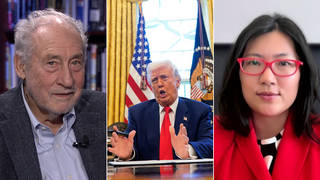
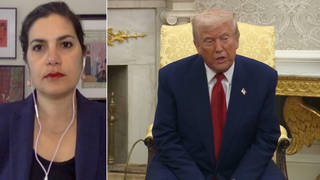
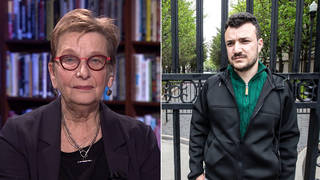
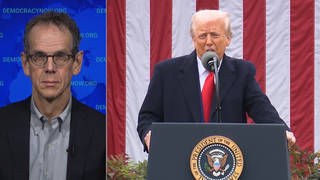






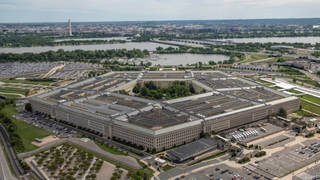
Media Options